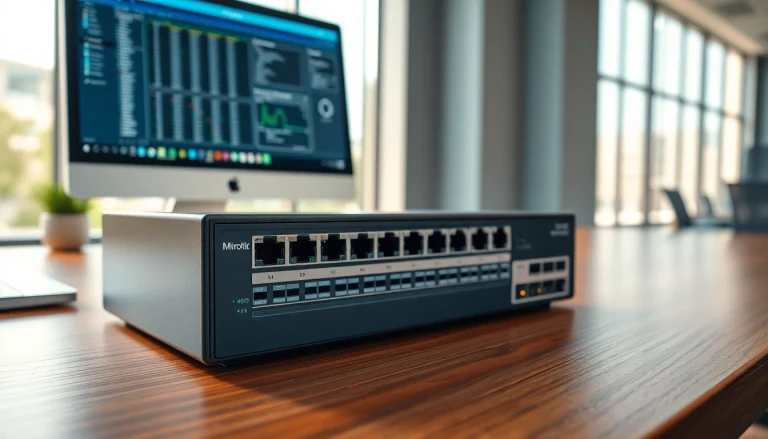
Introduction to Mikrotik Switch
As networking technology continues to evolve, the demand for efficient, reliable, and versatile network management solutions becomes increasingly significant. The Mikrotik Switch stands out as an integral tool in modern networking infrastructures. By enabling seamless connectivity and enhanced control over network traffic, Mikrotik Switch offers a suite of features designed to meet the diverse needs of organizations, from small businesses to large enterprises.
What is a Mikrotik Switch?
A Mikrotik Switch is a networking device designed to connect multiple devices within a Local Area Network (LAN). Unlike traditional switches, Mikrotik Switches are embedded with RouterOS, a powerful operating system known for its advanced functionality. This integration allows users to not only connect their devices for communication but also manage the network traffic and performance more effectively.
Key Features of Mikrotik Switch
Mikrotik Switches come equipped with several key features that distinguish them from conventional networking switches. Some notable features include:
- RouterOS Integration: Each Mikrotik Switch runs on RouterOS, providing comprehensive routing capabilities alongside switching functions.
- VLAN Support: Mikrotik Switches support Virtual Local Area Networks (VLANs), allowing for better organization and management of network traffic.
- Quality of Service (QoS): The QoS feature lets network administrators prioritize traffic to ensure critical applications get the bandwidth they need.
- Layer 2 and Layer 3 Switching: They support both Layer 2 (data link layer) and Layer 3 (network layer) switching, enhancing routing capabilities within the network.
- Monitoring Tools: Built-in diagnostic tools help administrators monitor the health and performance of the network.
Common Use Cases for Mikrotik Switch
Mikrotik Switches are utilized in various networking scenarios, including:
- Office Networks: Ideal for connecting employee workstations, printers, and servers while managing traffic effectively.
- Data Centers: Suitable for high-capacity environments where efficient data routing and performance management are crucial.
- ISPs and Service Providers: Used by Internet Service Providers to facilitate connections for their customers while monitoring traffic and performance metrics.
Benefits of Using Mikrotik Switch
Enhanced Network Performance
One of the primary advantages of incorporating a Mikrotik Switch into a network is the substantial enhancement in overall network performance. The built-in RouterOS allows for optimized routing protocols that ensure packets are delivered in the most efficient manner. The ability to monitor bandwidth, manage connections, and implement quality of service significantly reduces latency and improves the experience for end-users, whether they are engaged in video conferencing, online gaming, or accessing cloud services.
Scalability and Flexibility of Mikrotik Switch
Scalability is critical for businesses as they expand. Mikrotik Switches can easily adapt to growing network demands without necessitating a complete hardware overhaul. Businesses can add additional ports or connect more devices as needed, maintaining robustness in their networking infrastructure. The flexibility offered by VLANs enables businesses to segment their networks effectively, ensuring security and efficient traffic management.
Cost-Effectiveness in Networking Solutions
Acquiring a Mikrotik Switch is often more cost-effective compared to other high-end switching solutions. Mikrotik products provide enterprise-level features at a fraction of the cost, allowing small and medium-sized enterprises to benefit from professional-grade hardware without breaking the bank. This cost efficiency translates into a lower Total Cost of Ownership (TCO) and a more predictable budgeting model for IT expenditures.
Setting Up Mikrotik Switch
Installation Steps for Mikrotik Switch
Setting up a Mikrotik Switch involves several straightforward steps:
- Unboxing and Physical Setup: Remove the Mikrotik Switch from its packaging and ensure it is in a well-ventilated area. Connect the power supply.
- Connect to the Network: Plug in the Ethernet cables from your devices to the switch ports.
- Access the Device: Use a computer connected to the same network to access the Mikrotik Switch via a web browser or Winbox application.
Basic Configuration Options
After setting up the Mikrotik Switch physically, the next step is to configure it. Basic configurations include:
- IP Addressing: Assign an IP address to the switch to enable management.
- VLAN Configuration: Set up VLANs to segment traffic appropriately.
- QoS Settings: Configure traffic prioritization based on network needs.
Connecting Devices to Mikrotik Switch
To connect devices, follow the physical setup by plugging in Ethernet cables from various network devices—such as computers, printers, and servers—into the switch ports. Ensure that each device is correctly configured to communicate within the set network parameters established in the previous configuration steps.
Advanced Features of Mikrotik Switch
VLAN Implementation with Mikrotik Switch
VLANs (Virtual Local Area Networks) play a crucial role in network segmentation, enhancing security and performance. Mikrotik Switch allows for easy VLAN configuration through its user-friendly interface, enabling administrators to create isolated network segments within the same physical infrastructure. For example, an organization can separate its HR and IT departments into different VLANs, ensuring that sensitive data is kept secure and reducing unnecessary traffic between departments.
Quality of Service (QoS) Settings
Quality of Service (QoS) is essential for managing bandwidth allocation effectively. Mikrotik Switch offers QoS settings that enable network administrators to prioritize specific types of traffic. For instance, video conferencing and VoIP applications can be prioritized over file downloads to enhance user experience. By applying rules through RouterOS, businesses can ensure critical applications receive the appropriate bandwidth, mitigating issues like lag and connectivity loss during peak usage times.
Monitoring and Managing Mikrotik Switch
Integrating a Mikrotik Switch into your network also provides robust monitoring tools to manage performance comprehensively. The Device Management Dashboard within RouterOS offers real-time insights into network traffic, device status, and performance metrics. Admins can take a proactive approach to manage their network, swiftly addressing any anomalies or performance drops. Additionally, logging features can assist in troubleshooting and identifying long-term trends in network usage, which can inform future upgrades and adjustments.
Conclusion and Best Practices
Maintaining Your Mikrotik Switch
Regular maintenance is vital for the longevity and performance of your Mikrotik Switch. Best practices include:
- Firmware Updates: Regularly update the RouterOS to ensure that you have the latest features and security patches.
- Backup Configuration: Regularly back up your device configuration to avoid loss of settings in case of hardware failure.
- Physical Inspection: Periodically check physical connections and the environment to prevent overheating or dust accumulation.
Common Troubleshooting Tips
Even with proper setup, issues may arise. Here are common troubleshooting tips for Mikrotik Switch users:
- Check Connections: Ensure all cables are securely connected and functioning.
- IP Configuration: Confirm that the IP settings are correctly configured for all devices on the network.
- Examine Logs: Utilize the logging feature to diagnose problems by reviewing error logs or connection attempts.
Future Trends in Networking with Mikrotik Switch
As IoT devices proliferate and businesses migrate to cloud-based solutions, the need for versatile and scalable networking solutions will grow. Mikrotik Switch stands ready to adapt to these changing demands, with potential trends including enhanced support for wireless technology, increased automation capabilities, and integrated cybersecurity features. Staying ahead with a Mikrotik Switch could help organizations capitalize on future networking innovations while maintaining an efficient infrastructure.






